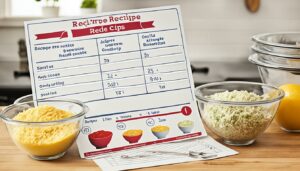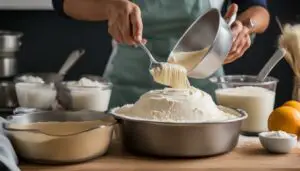Originally posted on November 12, 2023 @ 5:13 pm
Are you a baking enthusiast looking to increase your bread-making output? Perhaps you’re wondering whether you can double a bread recipe? The good news is that you can! However, there are a few important tips and guidelines you need to follow to ensure that your doubled bread recipe turns out perfectly.
In this comprehensive guide, we will explore the fundamentals of doubling a bread recipe, including ingredient measurements, proportion adjustments, mixing and kneading techniques, and baking temperature and time. We will also provide tips for troubleshooting common problems and adapting a recipe for different types of bread.
Whether you’re a seasoned bread baker or a novice, our easy-to-follow instructions will help you scale up your bread-making like a pro!
Contents
- 1 Understanding the Basics of Doubling a Bread Recipe
- 2 Calculating Ingredient Measurements for Doubled Bread Recipes
- 3 Adjusting Proportions in a Doubled Bread Recipe
- 4 Mixing and Kneading Techniques for Doubled Bread Dough
- 5 Adjusting Proofing and Rising Times for Doubled Bread Dough
- 6 Baking Temperature and Time for Doubled Bread Loaves
- 7 Troubleshooting Common Issues when Doubling Bread Recipes
- 8 Variations and Adjustments for Different Bread Types
- 9 Storing and Freezing Extra Bread from Doubled Recipes
- 10 Trying New Recipes and Experimenting with Doubling
- 11 Conclusion
- 12 FAQ
- 12.1 Can you double a bread recipe?
- 12.2 What are the basics of doubling a bread recipe?
- 12.3 How do you calculate ingredient measurements for a doubled bread recipe?
- 12.4 How do you adjust proportions in a doubled bread recipe?
- 12.5 What are the mixing and kneading techniques for doubled bread dough?
- 12.6 How do you adjust proofing and rising times for doubled bread dough?
- 12.7 What are the baking temperature and time for doubled bread loaves?
- 12.8 What are common issues when doubling bread recipes and how to troubleshoot them?
- 12.9 How do you adjust and double recipes for different bread types?
- 12.10 How do you store and freeze extra bread from doubled recipes?
- 12.11 Can you try new recipes and experiment with doubling?
- 12.12 Conclusion
Key Takeaways
- Doubling a bread recipe requires adjustments to ingredient measurements and proportion considerations.
- Proper mixing and kneading techniques are crucial when working with doubled bread dough.
- Adjusting proofing and rising times is necessary when doubling a bread recipe.
- The appropriate baking temperature and time may differ when baking larger bread loaves.
- Experimenting with different bread recipes and flavors is encouraged once you’ve mastered doubling a recipe.
Understanding the Basics of Doubling a Bread Recipe
Before attempting to double a bread recipe, it’s important to understand the basics. Here are some essential tips to keep in mind:
- Choose a recipe that lends itself well to doubling: Not all bread recipes are created equal, and some may not produce consistent results when doubled. As a general rule, it’s best to choose recipes that are straightforward, with simple ingredient lists and a straightforward mixing process. Avoid recipes with complex steps, as these may be more difficult to scale up successfully.
- Adjust ingredient measurements: When doubling a recipe, you’ll need to adjust the ingredient measurements accordingly. This means doubling the amount of flour, yeast, water, salt, and any other ingredients. We’ll cover the specifics of this process in the next section.
- Consider the mixing and kneading process: Doubling the recipe will also affect the mixing and kneading process. You may need to mix and knead the dough for longer than usual to ensure that all the ingredients are well incorporated.
- Allow for longer rising times: When doubling a bread recipe, the dough may take longer to rise. Be patient and allow enough time for the dough to double in size before moving on to the next step.
- Adjust baking time and temperature: Finally, be prepared to adjust the baking time and temperature as needed. A larger loaf may take longer to bake fully at the same temperature as a smaller loaf. Use a thermometer to check the internal temperature of the bread and adjust the baking time and temperature as needed.
By following these basic tips, you’ll be well on your way to successfully doubling any bread recipe.
Calculating Ingredient Measurements for Doubled Bread Recipes
Doubling a bread recipe requires some calculations to adjust the measurements of ingredients accurately. To ensure the bread turns out perfectly, each ingredient must be multiplied correctly. Here is a simple method to calculate the new measurements of each ingredient when scaling up a bread recipe:
- Write down the original measurements of the recipe.
- Multiply each ingredient’s measurement by two.
- Convert any odd measurements to the nearest practical size. For example, if the recipe calls for 1 and 1/3 cups of flour, round it up to 1 and 1/2 cups.
- Write down the new measurements for all ingredients in the recipe, including the flour, yeast, salt, and any other ingredients required.
It is important to note that some ingredients, such as yeast, may not need to be doubled. Check the yeast packaging for instructions on how much to use per batch of bread dough.
Example table of adjusted ingredient measurements:
| Ingredient | Original Quantity | Doubled Quantity |
|---|---|---|
| Flour | 3 cups | 6 cups |
| Yeast | 2 tsp | 3 tsp (check package instructions) |
| Salt | 1 tsp | 2 tsp |
| Water | 1 and 1/4 cups | 2 and 1/2 cups |
Following these guidelines should result in a perfectly adjusted bread recipe that can be scaled up accordingly. Happy baking!
Adjusting Proportions in a Doubled Bread Recipe
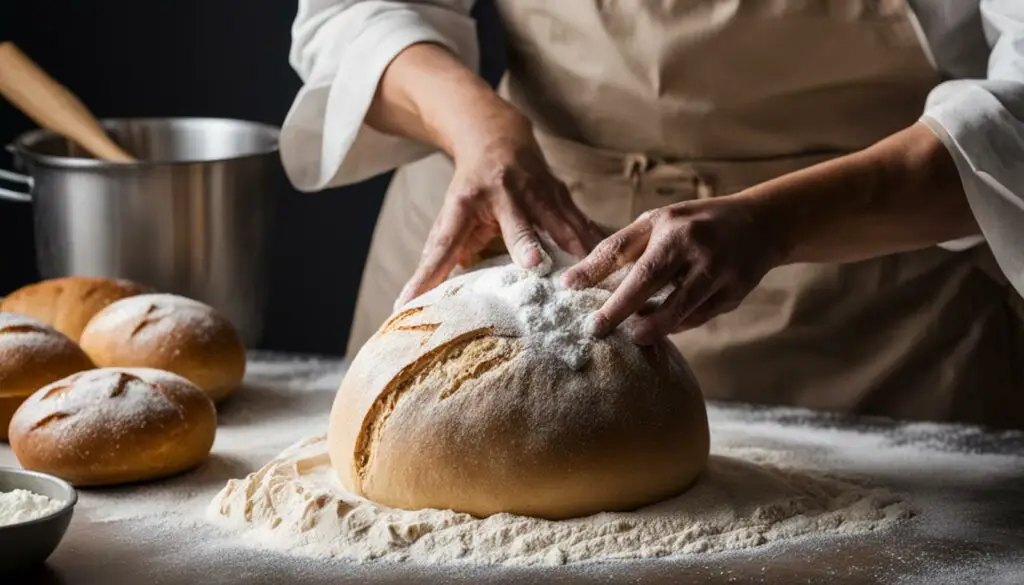
Doubling a bread recipe means adjusting the proportions of each ingredient to maintain the texture and flavor of the bread. It’s not just a matter of doubling each measurement, as this can result in an imbalanced recipe that produces a less-than-ideal loaf of bread. Here are some guidelines for modifying a bread recipe for a larger batch:
- Start with the flour: Since flour is the primary ingredient in bread dough, it’s essential to balance its amount when doubling a recipe. Use a formula where you multiply the original flour measurement by two and then subtract the weight of the remaining ingredients. For instance, if your original bread recipe calls for 500 grams of flour and you are adding 100 grams of sugar and 10 grams of salt, you will need to double the flour amount and subtract the weight of the other ingredients. The new flour measurement will be 880 grams, calculated as follows: (500 x 2) – (100 + 10) = 880.
- Adjust the leavening agent: Yeast or baking powder needs to be adjusted when doubling a bread recipe. If you’re using yeast, it’s best to use fresh yeast and double the amount you would typically use. For example, if your original recipe calls for 10 grams of yeast, you’ll need 20 grams of yeast when doubling the recipe. If you’re using baking powder, use the same amount as in the original recipe, as it doesn’t need to be adjusted based on the quantity of flour.
- Balance the salt: Salt is necessary to flavor bread dough and help it rise. However, too much salt can inhibit yeast activity and result in a dense loaf. When doubling a bread recipe, use 1.5 times the amount of salt in the original recipe. For example, if your original recipe calls for 10 grams of salt, you’ll need to use 15 grams of salt when doubling the recipe.
- Adjust liquids: Liquids such as water, milk, and eggs need to be adjusted when doubling a bread recipe. Use the same amount of liquid as in the original recipe, then add more as needed to achieve the desired consistency of dough. It’s best to add liquids gradually and knead the dough well in between additions, as too much liquid can make the dough sticky and difficult to handle.
- Consider other minor adjustments: Depending on the bread recipe, other minor adjustments may be necessary when doubling the recipe. For example, if you’re making a whole wheat bread that tends to be denser, you may need to add more yeast or let the dough rise longer to achieve a fluffy texture. Similarly, if you’re making a bread with seeds or other additions, you may need to adjust the amount of those ingredients when doubling the recipe.
By following these guidelines for modifying a bread recipe for a larger batch, you’ll be on your way to baking delicious, fluffy loaves that are sure to impress. Remember, practice makes perfect, and don’t be afraid to experiment with different bread types and variations!
Mixing and Kneading Techniques for Doubled Bread Dough

Mixing and kneading are essential steps in bread-making that can impact the quality of the final product. When doubling a bread recipe, it’s important to use the appropriate mixing and kneading techniques to ensure that the dough is well-developed and ready for rising.
Tip #1: Use a stand mixer or bread machine for larger batches of dough. Hand-mixing may not be sufficient for doubled bread recipes.
Tip #2: Start by mixing the ingredients in a large mixing bowl or the bowl of a stand mixer. Mix until the ingredients are just combined.
Tip #3: Once the ingredients are combined, switch to a dough hook and begin kneading the dough. Knead the dough for 10-15 minutes or until it becomes smooth and elastic. The dough should be able to stretch without breaking.
Tip #4: If the dough is too sticky, gradually add more flour until the desired consistency is reached.
Tip #5: If the dough is too dry, gradually add more water until the desired consistency is reached.
Tip #6: To ensure that the dough is well-kneaded, perform a “windowpane test.” Take a small piece of dough and stretch it between your fingers. If the dough is thin enough to be translucent and allows light to pass through without tearing, it has been kneaded sufficiently.
Using these techniques, you can successfully mix and knead doubled bread dough and achieve consistent results.
Adjusting Proofing and Rising Times for Doubled Bread Dough
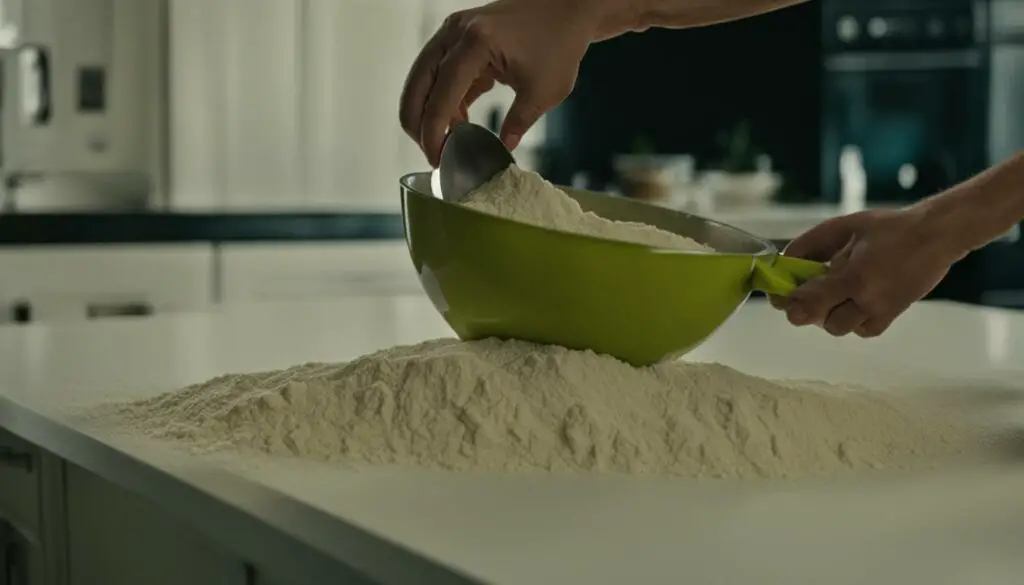
Doubling a bread recipe can impact the proofing and rising times needed for the dough to develop properly. The increased amount of dough requires a longer period to proof and rise, which is necessary for achieving the desired texture and flavor in the bread.
When proofing and rising doubled bread dough, follow these tips to ensure success:
- Allow enough time: Generally, doubling the amount of dough will require an additional 30 minutes to one hour for proofing and rising. However, the exact time needed will depend on the specific recipe and the room temperature. Keep a close eye on the dough and gauge its readiness by its size and texture.
- Choose the right location: The environment in which the dough proofs and rises plays a vital role in its development. When doubling the dough, ensure that it is placed in a warm and draft-free location. An oven with the light turned on can serve as a suitable proofing and rising environment.
- Avoid overproofing: While it’s essential to provide enough time for the dough to proof and rise correctly, overproofing can cause the bread to become dense and heavy. Keep a close eye on the dough and remove it from the proofing environment when it has doubled in size.
By adjusting the proofing and rising times when doubling a bread recipe, you’ll ensure that the dough has adequate time to develop the best flavor and texture. The next section will provide guidance on determining the appropriate baking temperature and time when baking doubled bread loaves.
Adjusting Baking Temperature and Time for Doubled Bread Loaves
In the next section, we’ll discuss how to determine the right baking temperature and time for doubled bread loaves to ensure even baking and fully cooked bread.
Baking Temperature and Time for Doubled Bread Loaves
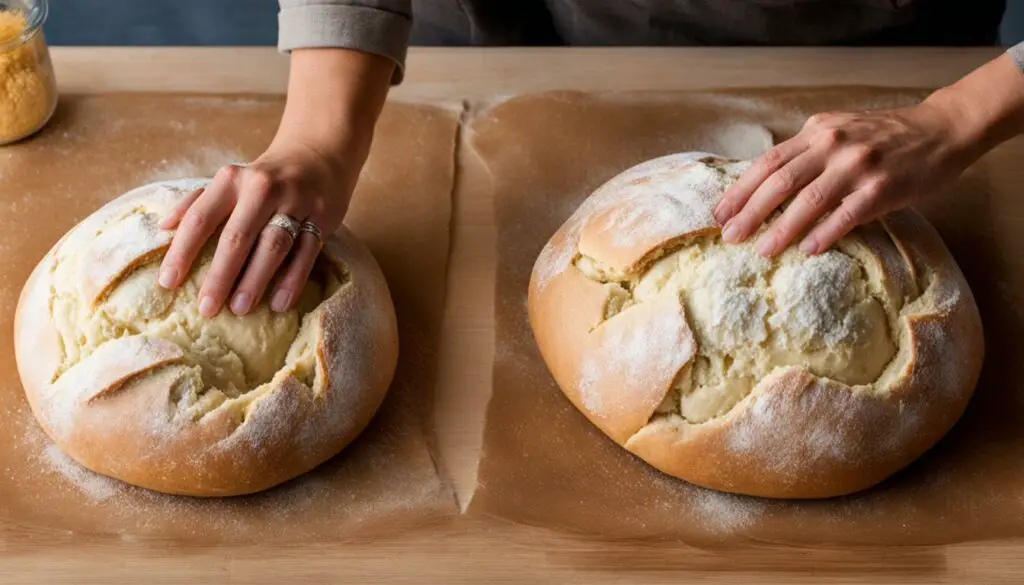
When you’re baking a larger batch of bread, you’ll likely need to adjust the baking temperature and time to ensure even baking and a fully cooked loaf. Here are some tips to help you get it right:
- Lower the oven temperature: The general rule of thumb is to lower the oven temperature by 25 degrees Fahrenheit when baking larger loaves of bread. This will help ensure that the bread is evenly baked without getting too dark on the outside or undercooked on the inside.
- Extend the baking time: In addition to lowering the oven temperature, you’ll also need to extend the baking time to ensure that the center of the bread is fully cooked. Start with an additional 10-15 minutes of baking time and then check the bread with a digital thermometer to ensure it has reached an internal temperature of at least 190 degrees Fahrenheit.
- Use a baking stone: If you have a baking stone, use it to help distribute the heat evenly throughout the bread. Preheat the stone in the oven before placing the bread on top to help prevent the bottom of the bread from burning.
Remember, these are just general guidelines, and the exact temperature and baking time will depend on your recipe, oven, and altitude. Use a digital thermometer and rely on your senses to determine when the bread is fully baked and ready to enjoy.
Troubleshooting Common Issues when Doubling Bread Recipes
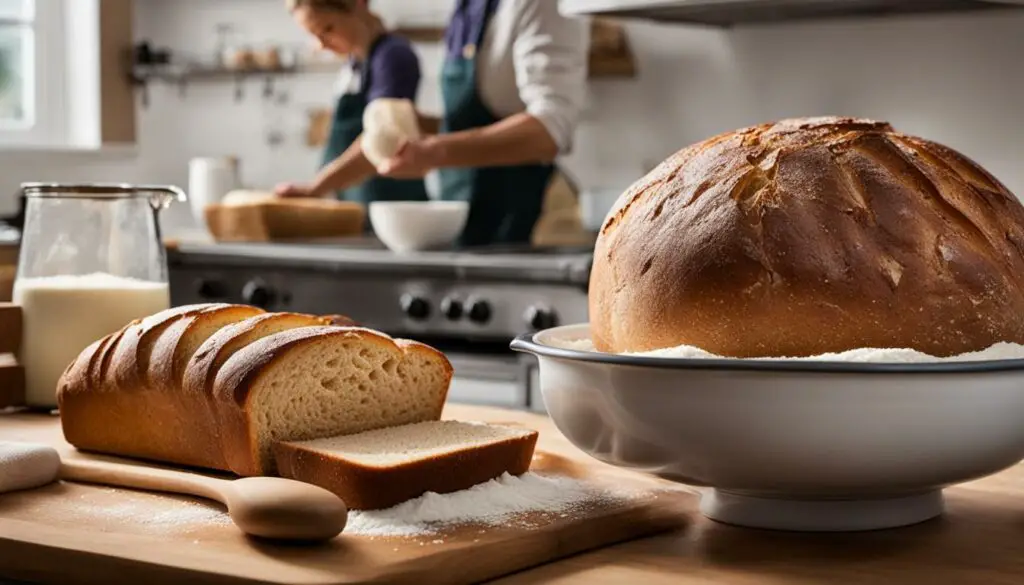
Despite following all the guidelines for doubling a bread recipe, things may not always turn out as expected. In this section, we will address some common issues that bakers may face and provide troubleshooting tips to overcome these challenges.
Problem: Dense Bread Texture
If your doubled bread recipe results in a dense and heavy texture, the most likely culprit is insufficient rising time or under-kneading the dough. To fix this issue, try increasing the dough’s rising time or kneading it for longer until it’s more elastic and fluffy.
Problem: Insufficient Rise
A loaf of bread that doesn’t rise enough may be due to various factors. The yeast could be stale or dead, the dough’s temperature could be too low, or the dough might not have received enough kneading, to begin with. To fix this issue, you may need to experiment with different types of yeast, or try using slightly warmer water while kneading.
Problem: Uneven Baking
If your doubled bread recipe is baking unevenly, it may be because of uneven positioning within the oven. Try rotating the bread loaves halfway through the baking process and ensuring equal distance between them and the heat source.
Another possible reason for uneven baking could be the bread dough’s shape or size. It’s important to ensure that the dough has been shaped and sized evenly before baking.
By addressing these issues, you can improve the quality and consistency of your doubled bread recipes.
Variations and Adjustments for Different Bread Types

While the process of doubling a bread recipe may be similar for most types of bread, different types may require specific adjustments. Here are some tips for doubling recipes for various bread types:
White Bread
When doubling a white bread recipe, make sure to adjust the proportions of salt, yeast, and flour accordingly. Increase the rising time by 10-15 minutes to ensure the larger loaves have enough time to rise properly.
Whole Wheat Bread
Doubling a recipe for whole wheat bread requires careful attention to the ingredient proportions. Since whole wheat flour absorbs more water than white flour, you may need to increase the amount of water in the recipe by 10-15%. Adding vital wheat gluten to the dough can also help improve the texture of larger loaves.
Sourdough Bread
Sourdough bread is a unique type of bread that requires a longer rising time and more patience. When doubling a sourdough bread recipe, make sure to give the dough plenty of time to ferment and rise. You may need to adjust the amount of starter used in the recipe to ensure the dough rises properly.
Rye Bread
Doubling a rye bread recipe can be challenging because rye flour has a different gluten structure than wheat flour. To ensure a successful outcome, consider using a blend of rye and wheat flour to help maintain the desired texture.
Experimentation is key when it comes to doubling bread recipes for different types of bread. By understanding the nuances and characteristics of each type of bread, you can fine-tune your recipes to achieve the best results.
Storing and Freezing Extra Bread from Doubled Recipes
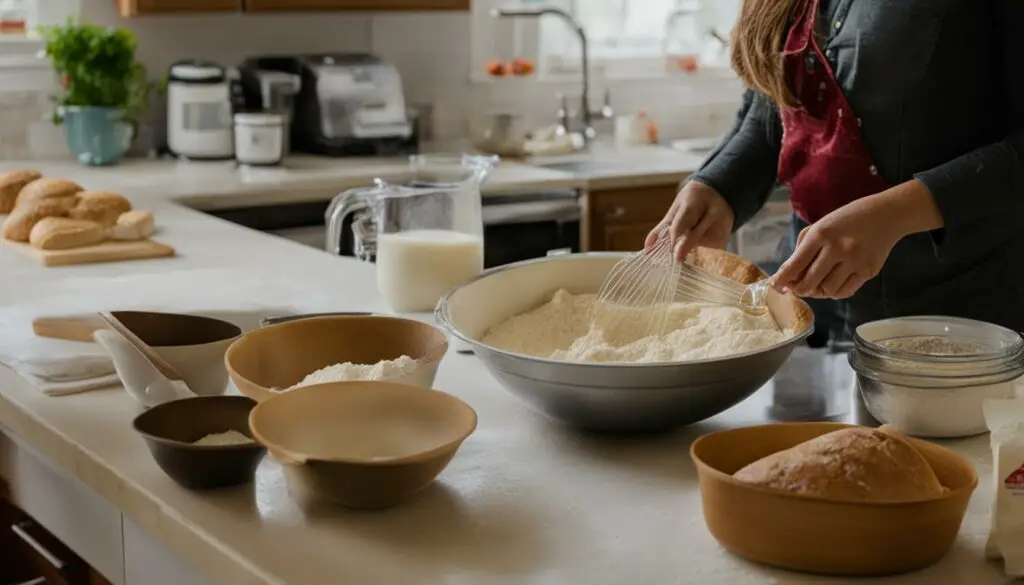
When you double a bread recipe, it’s common to end up with more loaves than you can eat immediately. Properly storing and freezing your bread can help you enjoy it for longer periods.
If you plan to consume the extra bread within a few days, wrap it in plastic or foil and store it at room temperature in a dry place. Avoid storing bread in the fridge, as it can dry out the bread and affect its texture.
To freeze bread, first, let it cool completely to room temperature. Then, wrap it tightly in plastic wrap and place it in an airtight container or freezer bag. Frozen bread can stay fresh for up to three months.
When you’re ready to enjoy your frozen bread, remove it from the freezer and let it thaw at room temperature for a few hours. You can also reheat the bread in the oven at 350°F for about 10-15 minutes for a fresh-baked taste.
Pro tip: Slice the bread before freezing it, so you can easily take out just the amount you need for each meal.
Table: Guide to Storing and Freezing Doubled Bread
| Storage Method | Temperature | Duration |
|---|---|---|
| Room Temperature | 68-72°F | Up to 5 days |
| Refrigerator | Approx. 40°F | Up to 1 week |
| Freezer | 0°F or lower | Up to 3 months |
By following these simple tips, you can enjoy your doubled bread for weeks to come and eliminate food waste.
Trying New Recipes and Experimenting with Doubling
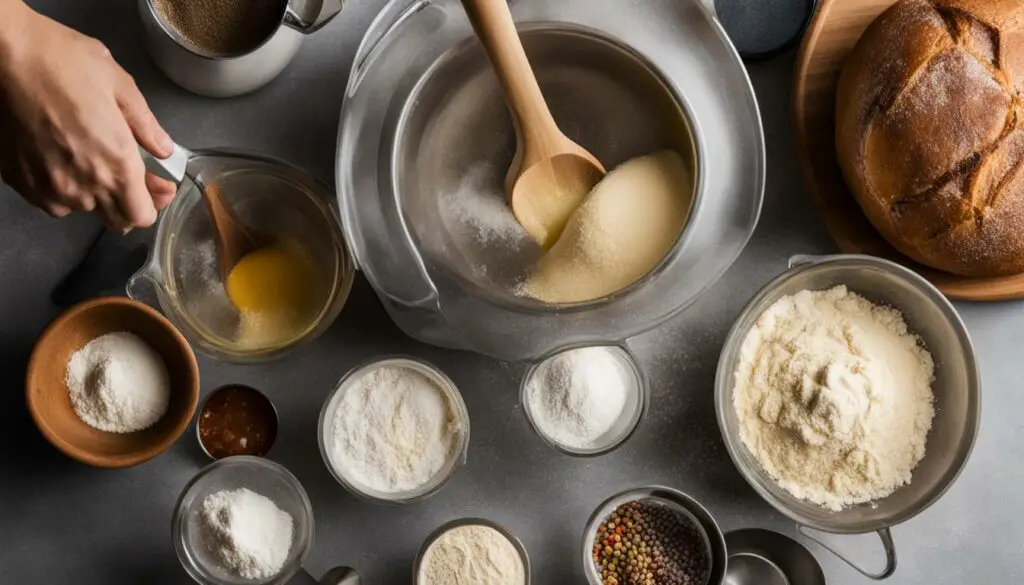
Once you feel confident with doubling bread recipes and have successfully baked larger batches of your favorite bread, it’s time to get creative and experiment with new recipes! Doubling a bread recipe opens up a world of possibilities, allowing you to try different flavor combinations and techniques.
One tip for experimenting with new recipes is to start small. Instead of doubling an entirely new recipe, try doubling just one ingredient at a time. For example, if a recipe calls for one type of flour, try substituting half of the flour with a different type to see how it affects the texture and flavor of the bread. This way, you can gradually introduce new ingredients and flavor combinations without risking a failed recipe.
Another way to experiment with doubling recipes is to try making different types of bread. Every type of bread has its own unique characteristics and requirements, and doubling a recipe for each one requires specific adjustments. For example, sourdough bread requires longer rise times and different handling techniques than white bread. Be open to trying new bread types and researching the adjustments needed for successful doubling.
Lastly, don’t be afraid to put your own twist on traditional bread recipes. Add new spices, herbs, or even fruits and vegetables to the dough for a unique flavor and texture. You can also experiment with different shapes and sizes for your loaves.
Remember, the key to successful experimentation is to have fun and be patient. Not every experiment will turn out perfectly, but every attempt is an opportunity to learn and improve your skills. Happy baking!
Conclusion
Doubling a bread recipe can be a game-changer for bakers looking to produce larger batches of their favorite bread. However, multiplying ingredients in a bread recipe requires careful adjustments and considerations. By following the tips and guidelines outlined in this guide, you can confidently scale up your bread-making and achieve consistent and delicious results every time.
Remember, understanding the basics of doubling a bread recipe, calculating ingredient measurements, adjusting proportions, and using the right mixing and kneading techniques are essential for success. Additionally, make sure to adjust the proofing and rising times and baking temperature and time to ensure even baking and fully cooked loaves.
Don’t let common issues discourage you from experimenting with new recipes and different bread types. And when you have extra loaves from a doubled recipe, store and freeze them properly to enjoy delicious homemade bread for weeks to come.
Happy Baking!
FAQ
Can you double a bread recipe?
Yes, you can double a bread recipe. In fact, doubling a bread recipe is a great way to bake larger batches and save time. However, there are some tips and guidelines you need to follow to ensure successful results.
What are the basics of doubling a bread recipe?
Before attempting to double a bread recipe, it’s important to understand the basics. You need to make adjustments to ingredient measurements and proportions. This section will cover the key tips and considerations for doubling a bread recipe.
How do you calculate ingredient measurements for a doubled bread recipe?
When doubling a bread recipe, it’s crucial to make the right adjustments to ingredient measurements. We will provide a simple method for calculating the new quantities of flour, yeast, water, and other ingredients when scaling up a bread recipe.
How do you adjust proportions in a doubled bread recipe?
Doubling a bread recipe requires adjusting the proportions to maintain the desired texture and flavor. In this section, we will discuss the importance of balancing the flour, yeast, salt, and other ingredients to ensure a successful outcome when making a larger batch of bread.
What are the mixing and kneading techniques for doubled bread dough?
Working with doubled bread dough presents unique challenges during the mixing and kneading process. Here, you’ll find valuable tips and techniques to ensure that your dough is well-mixed, properly developed, and ready for a successful rise.
How do you adjust proofing and rising times for doubled bread dough?
Doubling a bread recipe can impact the time it takes for the dough to proof and rise. In this section, we will share essential tips for adjusting the proofing and rising times so that your bread dough has adequate time to develop flavor and rise to perfection.
What are the baking temperature and time for doubled bread loaves?
Doubling a bread recipe may require adjustments to the baking temperature and time to ensure even baking and a fully cooked loaf. In this section, we will provide expert guidance on determining the appropriate baking temperature and time for larger bread loaves.
What are common issues when doubling bread recipes and how to troubleshoot them?
Despite following all the guidelines, issues can still arise when doubling a bread recipe. This section will address common problems that bakers may encounter, such as dense texture, insufficient rise, or uneven baking. We’ll provide troubleshooting tips to help you overcome these challenges.
How do you adjust and double recipes for different bread types?
Different types of bread may require specific adjustments and variations when doubling a recipe. In this section, we will explore how to double recipes for various bread types, including white bread, whole wheat bread, sourdough bread, and more.
How do you store and freeze extra bread from doubled recipes?
When doubling a bread recipe, you’ll likely end up with more loaves than you can consume immediately. This section will provide helpful tips on storing and freezing the extra bread to ensure it stays fresh and delicious for longer periods.
Can you try new recipes and experiment with doubling?
Once you’ve mastered the art of doubling bread recipes, it’s time to unleash your creativity and experiment with new recipes. In this section, we will encourage bakers to explore different flavors, ingredients, and techniques when doubling their favorite bread recipes.
Conclusion
Doubling a bread recipe opens up a world of possibilities for bakers. By following the tips and guidelines outlined in this guide, you can confidently scale up your favorite bread recipes and enjoy larger batches of freshly baked bread. Happy baking!


